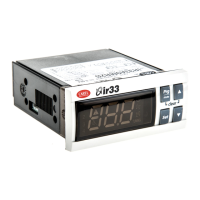Mode 8: Reverse function mode with selection of Set and differential from digital
input (pict. 12).
With this kind of function the variation of digital input (open/closed) does not change the
kind of action (always Reverse), but changes Set Point and differential.The main
parameters in this kind of function are active Set (St1) and differential (P1) with open digital
input and active Set (St2) and differential (P2) with closed digital input.
Mode 9: function with 2 Set Points, one in Direct and one in Reverse (pict. 13).
The main parameters in this kind of function are Set-point (St1), Direct mode differential
(P1), Set Point (St2) and Reverse mode differential (P2).This function is present in W and Z
versions, and is similar to mode 3 (function with Dead-Band) since half of the outputs are
active in Direct and half in Reverse.The difference is that there is no single fixed Set Point,
so you can work as if you had two independent instruments working with the same probe.
Special function.
This special mode gives no limits to the outputs management.This procedure allows you,
starting from one of the other 9 modes, to modify a great number of parameters.For each
output it is possible to select: reference Set, hysteresis, kind of action (Direct or Reverse,
with On/Off or PWM action), hysteresis between two adjacent outputs, etc. Moreover, it is
possible to select the digital input function, to define timings on outputs, activating times
and to select many other functions.For NTC input models, a second probe can be used to
make the instrument work in differential mode or to modify the Set Point according to the
temperature read by the second probe (compensation).The use of this mode requires a
certain experience as well as detailed information which cannot be found in this guide.To
get further information please ask for the Universal Infrared Series technical manual (code
+030220160).
48
Advanced set-up: Function Modes description
+05-3015 • rel.3.0 interno ok 18-09-2002 14:31 Pagina 48

